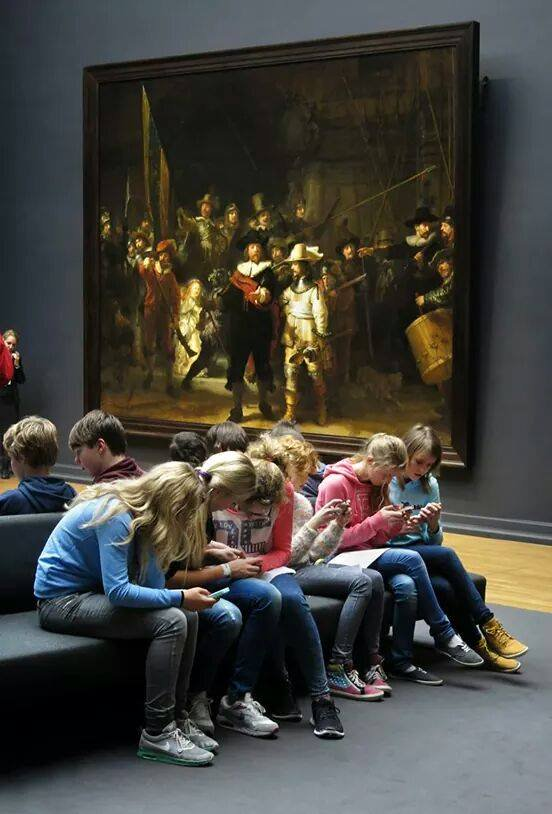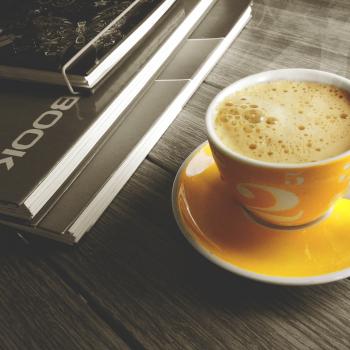I recently came upon a Facebook post I found fascinating. It was by a man named Steve Cobby, and started with this image:

This image was accompanied by the following text:
“Late last year this photograph of children looking at their smartphones by Rembrandt’s ‘The Night Watch’ in the Rijksmuseum in Amsterdam started doing the rounds on the web. It quickly became viral. It was often accompanied by outraged, dispirited comments such as “a perfect metaphor for our age”, “the end of civilisation” or “a sad picture of our society”.
Only they weren’t. It turns out that the Rijksmuseum has an app that, among other things, contains guided tours and further information about the works on display. As part of their visit to the museum, the children, who minutes earlier had admired the art and listened attentively to explanations by expert adults, had been instructed to complete an assignment by their school teachers, using, among other things, the museum’s excellent smartphone app.
I would like to think that all those who liked, posted, shared and tweeted the picture of children on smartphones by Rembrandt’s masterpiece in the erroneous belief that it illustrated everything that is wrong with society feel a tiny bit silly and a little more humble as a consequence. But it won’t happen.
The tragic thing is that this — the truth — will never go viral. So, I wonder, what is more likely to bring about the death of civilisation, children using smartphones to learn about art or the wilful ignorance of adults who are too quick to make assumptions?”Technology and the death of civilisation
http://buff.ly/1VxAtfF
Cobby’s point, in the midst of a world in which Millennials and other young people are constantly derided for their technology use and their supposed selfishness, is an important one. All is not always as it seems, and your assumptions about people often tell more about you than they do about reality. Smartphones, which are often seen as a sign of self-centered disconnection from the world, frequently serve as a source of education, connection, and, ultimately, empowerment.
I had this same thought, later, when reading a passionate social media rant hitting on similar themes, this one posted by a woman with agoraphobia. Have a look:

Here is the full text of her post:
Dear driver who yelled at me for taking a selfie on the sidewalk outside Trader Joe’s, I know what you thought you were seeing, just a self-absorbed, shallow millennial, documenting a mundane task for no reason. ‘Stupid kid,’ you might have thought, ‘not every little thing has to be documented. Put your phone away and get on with your life.’ But here’s the thing. I also know what you were unable to see: I am agoraphobic.
For the past 3+ years, I haven’t gone into public by myself. I haven’t left the front door of my home without a friend or family member (except, on brave days, to get the mail). Even when going in public with loved ones, I become wracked with anxiety, crippled by panic attacks where I could barely breathe or talk. My husband has had to practically carry me out of movie theaters becasue I started panicking so hard. We’ve lost who knows how much money on non-refundable tickets. Before we got married, we couldn’t go on dates because it was too hard for me to leave the house. I have endured 3+ years of my body and mind revolting against my desire to be independent.
This morning, alone in my apartment, I experienced a flash of strange courage. For once, I didn’t wait around to see if it would stay. I didn’t worry that the courage would abandon me halfway through my trip. I just seized it. I grabbed a beanie and my messenger bag and walked out the door. I crossed two streets, by myself, while cars rushed by, and I didn’t panic. I smiled up at the blue sky and sun, for the first time in year enjoying it on my own. I felt whole. I felt powerful. I felt free.
You and I were the sole witnesses of a moment 3+ years in the making. All I wanted was one photo — not even from a flattering angle, not even well-composed. Just one photo, to prove I did it, to look at when I’m low again, that it’s possible to defeat the demons and win. To show myself that it can be done again. To send to my husband so he can be proud of me too.
When you saw me, yes, I was a woman standing outside a Trader Joe’s, acting like my shopping trip was important enough to document. Because it was.
I’m sorry that you’ll never know.
I’m sorry you see my generation documenting our lives as something to be scorned.
I’m sorry you don’t hear the stories we have to tell.
I’m sorry that I can’t tell you mine.
Just as smartphones can be used for education and connection, those with various forms of mental illness or anxiety often use selfies as a form of empowerment. They’re a form of encouragement, a way of pushing back against the difficulties they face and saying “I can do it.” And that is beautiful.
These posts, and others like them, offer an important reminder. All is not always as it seems, and your assumptions are sometimes flat-wrong. This is actually something I try to think about when someone I don’t know cuts me off or engages in behavior that exasperates or confuses me in a public place. I don’t know what is going on in their lives, they don’t know what’s going on in my life, and that’s okay.
Judging people for otherwise harmless behavior never made anything better.










